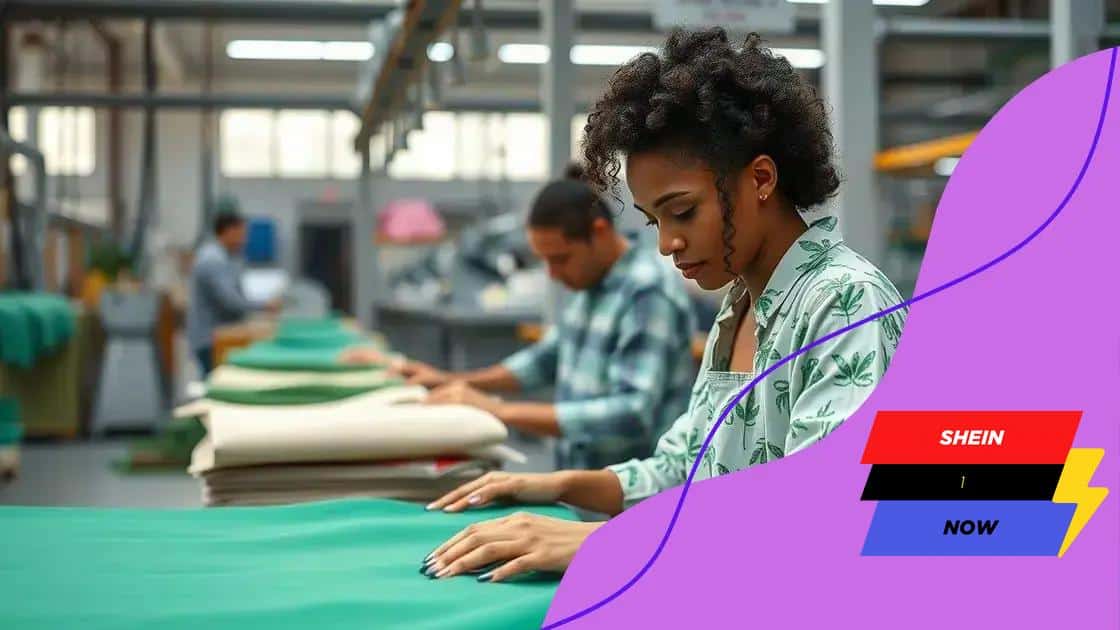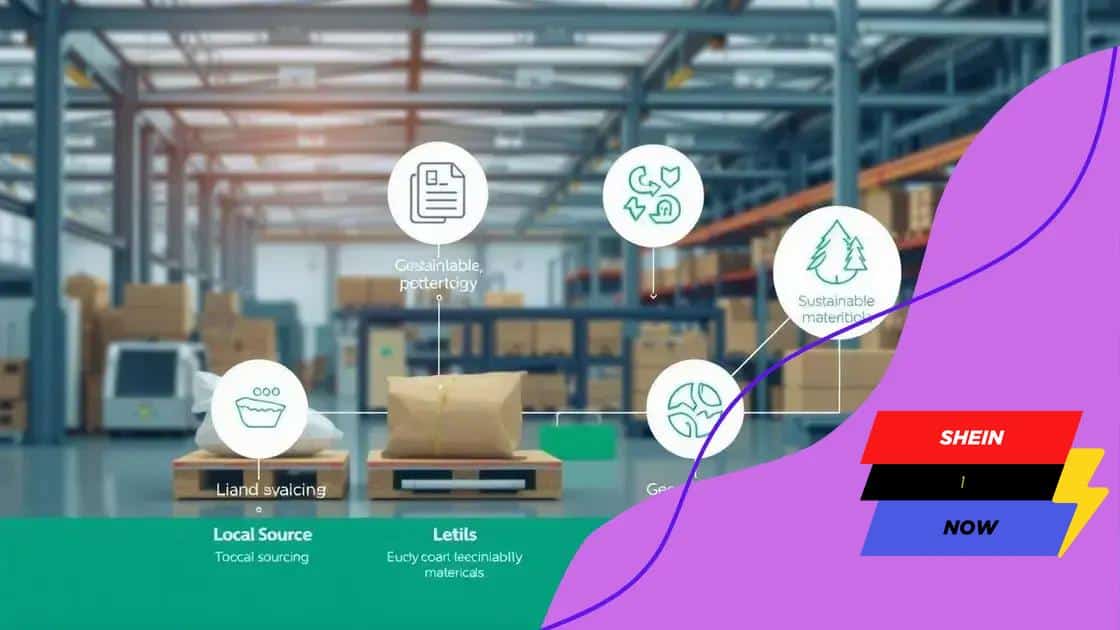Shein’s initiatives to reduce carbon footprint

Shein’s initiatives to reduce carbon footprint focus on innovative technologies, sustainable materials, and community engagement, aiming for a more eco-friendly approach in the fashion industry.
Shein’s initiatives to reduce carbon footprint are transforming the fashion landscape. You might wonder how a fast fashion giant is balancing profitability with planet-friendly practices. Let’s dive in.
Understanding Shein’s sustainability goals
Understanding Shein’s sustainability goals is crucial in evaluating how the brand is adapting to the evolving landscape of eco-conscious fashion. Shein aims to make a significant impact in reducing its environmental footprint, and it’s working hard to achieve that.
One of the key aspects of Shein’s sustainability strategy is its commitment to using more sustainable materials. By integrating recycled fabrics and organic materials, Shein is trying to minimize waste in the production process. This shift not only benefits the environment but also promotes responsible consumption among its customers.
Sustainable Production Practices
Shein is also focusing on improving its production practices. This includes:
- Reducing water usage in manufacturing.
- Implementing energy-efficient technologies.
- Adopting waste reduction processes.
By prioritizing sustainable production, Shein is making strides towards a more eco-friendly fashion line. Another important area is the transparency of its supply chain. Shein is aiming to provide clearer insights into where and how its products are made.
Community Engagement
Engaging with the community is a vital part of Shein’s strategy. The brand encourages consumers to participate in sustainability initiatives. Examples include:
- Recycling programs for old clothing.
- Partnerships with environmental organizations.
- Awareness campaigns on responsible fashion choices.
By involving its customers, Shein fosters a sense of collective responsibility towards the environment. Additionally, the brand is investing in innovative technologies to further reduce its carbon footprint and embrace sustainable practices.
Overall, Shein’s sustainability goals reflect a growing trend in the fashion industry to become more eco-conscious. By focusing on the use of sustainable materials, improving production practices, and engaging with the community, Shein is taking steps to balance fashion with responsibility.
Innovative technologies for reducing emissions
Innovative technologies for reducing emissions are key to Shein’s sustainability efforts. These advancements help the brand lessen its impact on the environment while continuing to deliver trendy fashion. Embracing modern technology allows Shein to streamline its processes and cut down on harmful emissions effectively.
One example of innovation is the use of advanced manufacturing techniques. These techniques not only save time but also reduce energy consumption. By optimizing production schedules and employing automation, Shein can operate more efficiently.
Eco-Friendly Materials
Integrating eco-friendly materials plays a critical role in emission reduction. Many of these materials come from sustainable sources and help in minimizing the carbon footprint. Examples include:
- Recycled polyester, which uses less energy compared to traditional polyester.
- Organic cotton, cultivated without harmful pesticides.
- Bio-based fabrics, which are made from natural materials that are renewable.
By incorporating these materials, Shein is not only addressing emissions but also promoting a circular economy within the fashion industry.
Energy Efficiency Improvements
Another significant focus is on enhancing energy efficiency in production facilities. Shein strives to utilize renewable energy sources like solar and wind. This minimizes reliance on fossil fuels, thus lowering greenhouse gas emissions.
Moreover, the brand invests in energy-efficient machinery that reduces energy use while maintaining production levels. Smart technology also allows for real-time monitoring of energy consumption, which can identify areas for improvement.
Overall, Shein’s approach to utilizing innovative technologies reflects its commitment to creating a more sustainable future. By focusing on new manufacturing techniques, eco-friendly materials, and energy-efficient practices, Shein is paving the way for more responsible fashion.
Impact of supply chain adjustments

The impact of supply chain adjustments is significant for Shein as it strives for a more sustainable future. By refining its supply chain, the brand can not only improve efficiency but also lessen its overall carbon footprint. These adjustments are crucial in creating a responsible fashion model that aligns with environmental goals.
One important adjustment involves sourcing materials closer to production facilities. This reduces the need for long-distance transportation, cutting down on emissions. When materials are sourced locally, the environmental impact of transporting goods is significantly lowered, thereby promoting more sustainable practices.
Collaboration with Sustainable Suppliers
Another area Shein focuses on is partnering with sustainable suppliers. These suppliers emphasize using eco-friendly materials and practices, further enhancing Shein’s commitment to sustainability. Some benefits of these collaborations include:
- Access to innovative materials that have a lower environmental impact.
- Shared resources for implementing sustainable practices.
- Improved transparency in the supply chain process.
By working together with these suppliers, Shein can create a more resilient and responsible supply chain.
Technology in Supply Chain Management
Technology plays a vital role in managing supply chain adjustments. Advanced technologies like AI and data analytics help Shein track its materials and monitor production. This data-driven approach allows for quicker adjustments in response to supply chain issues, reducing waste and improving efficiency.
Additionally, real-time monitoring ensures that Shein maintains a consistent flow of sustainable materials while keeping emissions to a minimum. With an adaptable supply chain, the brand can respond proactively to changing demands and sustainable practices.
Overall, the impact of supply chain adjustments is profound. By sourcing materials locally, collaborating with sustainable suppliers, and leveraging technology, Shein is paving the way for a more environmentally responsible future in the fashion industry.
Community engagement in sustainability efforts
Community engagement in sustainability efforts is a vital part of Shein’s approach to reducing its carbon footprint. By involving customers and local communities, Shein fosters a culture of sustainability that goes beyond just business practices. This engagement not only helps the environment but also strengthens the brand’s connection with its audience.
One way Shein engages with the community is through outreach programs. These programs aim to educate the public about sustainable fashion and encourage responsible consumption. By hosting workshops and events, Shein can raise awareness about the importance of making eco-friendly choices.
Sustainability Initiatives
Another aspect of community engagement includes various sustainability initiatives that invite direct participation. Some examples of these initiatives are:
- Clothing donation drives that encourage customers to recycle old garments.
- Partnerships with local non-profits focused on environmental conservation.
- Social media campaigns that promote eco-friendly practices among followers.
These initiatives not only benefit the environment but also create a sense of community among participants, fostering a shared commitment to sustainability.
Feedback and Collaboration
Shein also values feedback from its community. By listening to customers and engaging them in the decision-making process, Shein can incorporate suggestions related to its sustainability efforts. This feedback loop helps the brand identify areas for improvement and adapt its strategies accordingly.
Collaboration is essential for driving meaningful change. By partnering with local organizations and influencers, Shein amplifies its sustainability message and reaches a broader audience. Together, they can work on impactful projects that address environmental challenges.
Ultimately, community engagement is crucial for fostering awareness and promoting sustainable practices. By involving its customers and the broader community, Shein can create a positive impact that extends beyond its products, helping to build a more sustainable future.
Future outlook for sustainable fashion
The future outlook for sustainable fashion is bright as more brands, including Shein, are prioritizing eco-friendly practices. With increasing consumer awareness about environmental issues, there is a growing demand for sustainable products. This trend encourages companies to adopt innovative approaches to reduce their environmental impact.
One potential area of growth is the expansion of circular fashion. This model promotes recycling and reuse, reducing waste in the fashion industry. More brands are starting to implement take-back programs that encourage customers to return old garments for recycling. Such steps not only help reduce pollution but can also foster greater customer loyalty.
Technological Innovations
Technological advancements will play a crucial role in shaping sustainable fashion. From enhanced supply chain management to virtual fitting rooms, technology can help brands become more efficient. Key innovations include:
- 3D printing, which allows for precise manufacturing and minimizes waste.
- Biodegradable materials that can decompose naturally.
- AI-driven analytics to predict trends and manage inventory more efficiently.
These technologies will likely transform how brands produce clothing, making processes more sustainable and less resource-intensive.
Consumer Participation
As consumers become more attentive to sustainability, their participation will drive change. Shoppers are actively seeking brands that align with their values. Sustainable branding and transparent practices will be essential for attracting environmentally-conscious consumers. Engaging them in discussions about sustainability can lead to increased brand loyalty.
Moreover, sustainable fashion events, collaborations, and community outreach can further elevate the movement. As brands like Shein invest more in sustainability, we can expect to see a positive shift in how consumers perceive and engage with fashion. With a proactive approach, the fashion industry can create a more sustainable future, balancing style with environmental responsibility.
FAQ – Common Questions About Shein’s Sustainable Initiatives
What are Shein’s main strategies for reducing its carbon footprint?
Shein focuses on innovative technologies, sustainable materials, and community engagement to lower its environmental impact.
How does community involvement enhance Shein’s sustainability efforts?
Community involvement promotes awareness and encourages participation in sustainability initiatives, creating a collective effort for eco-friendly practices.
What role does technology play in Shein’s approach to sustainability?
Technology allows Shein to optimize production, track materials in real-time, and reduce waste, making processes more efficient and green.
What is circular fashion and how does Shein apply it?
Circular fashion emphasizes recycling and reusing materials, which Shein supports through take-back programs and initiatives that minimize waste.





